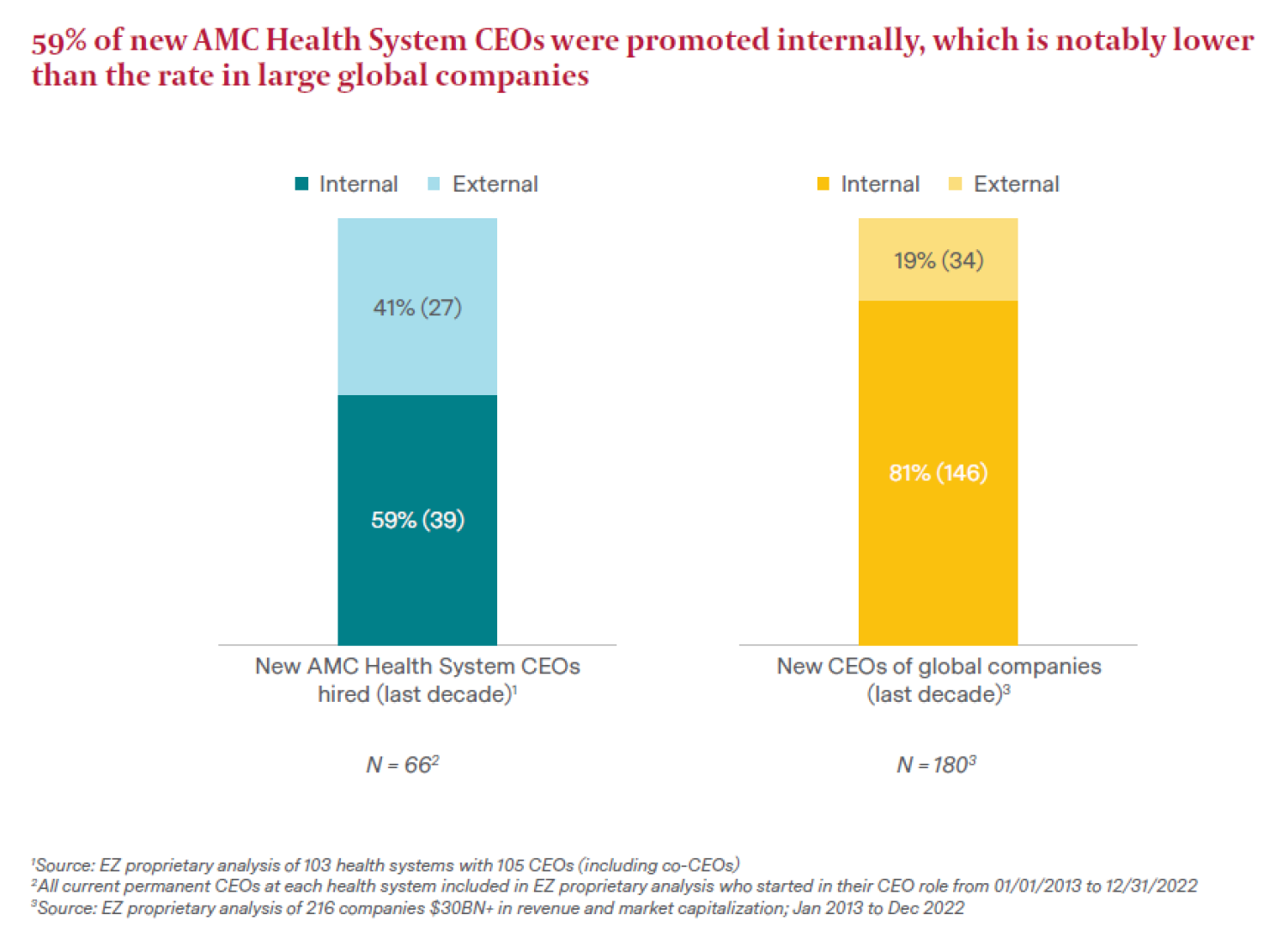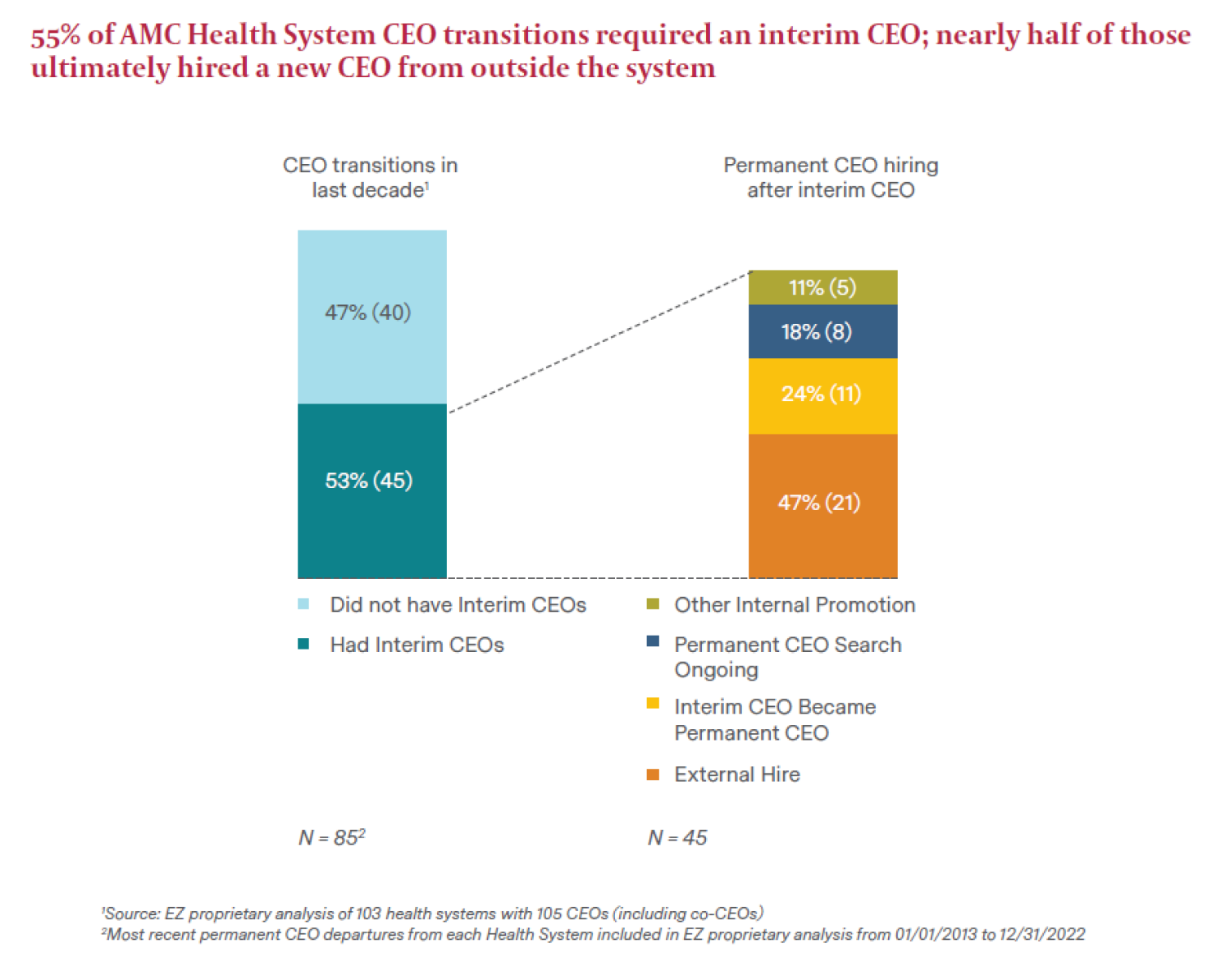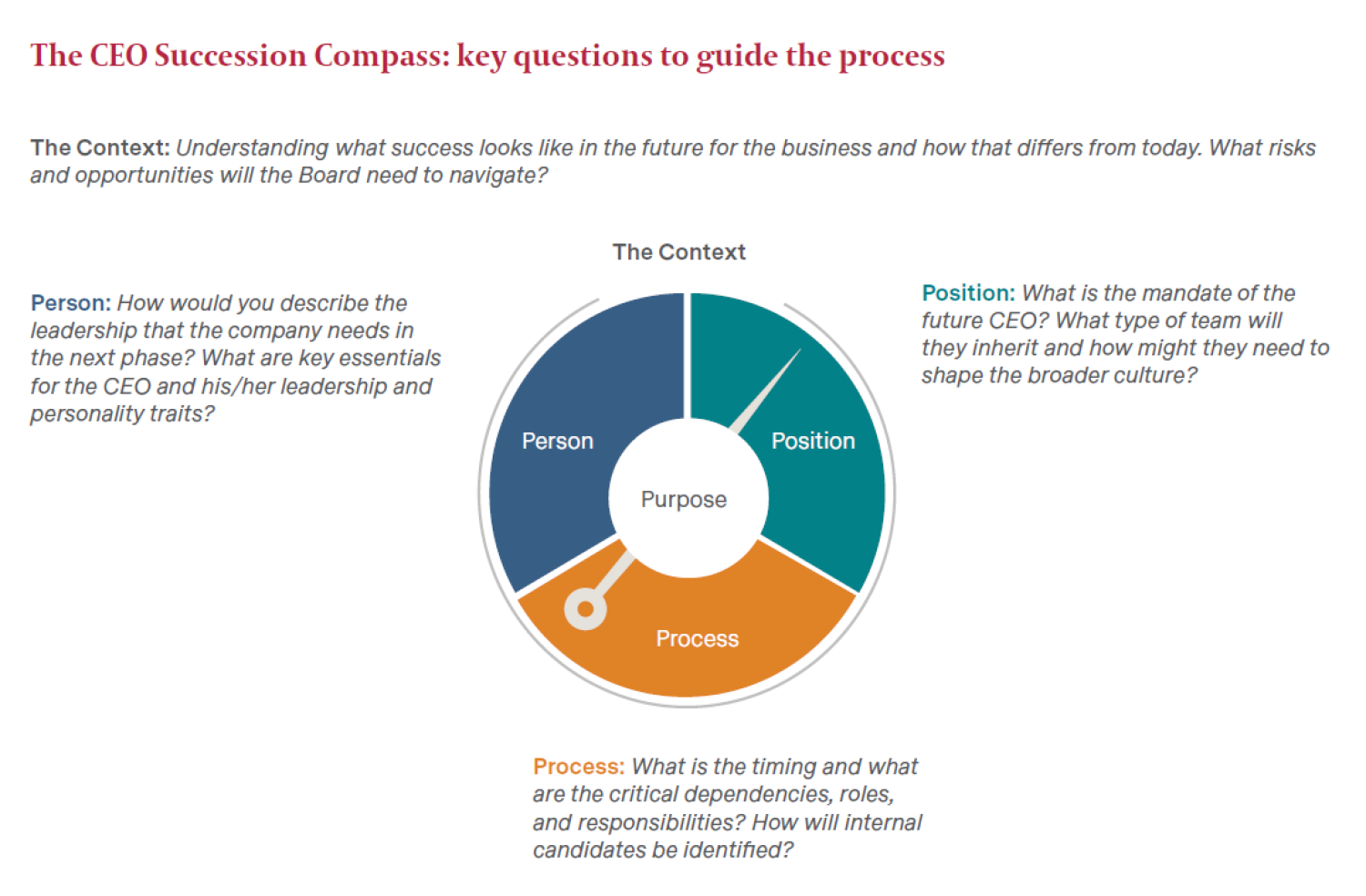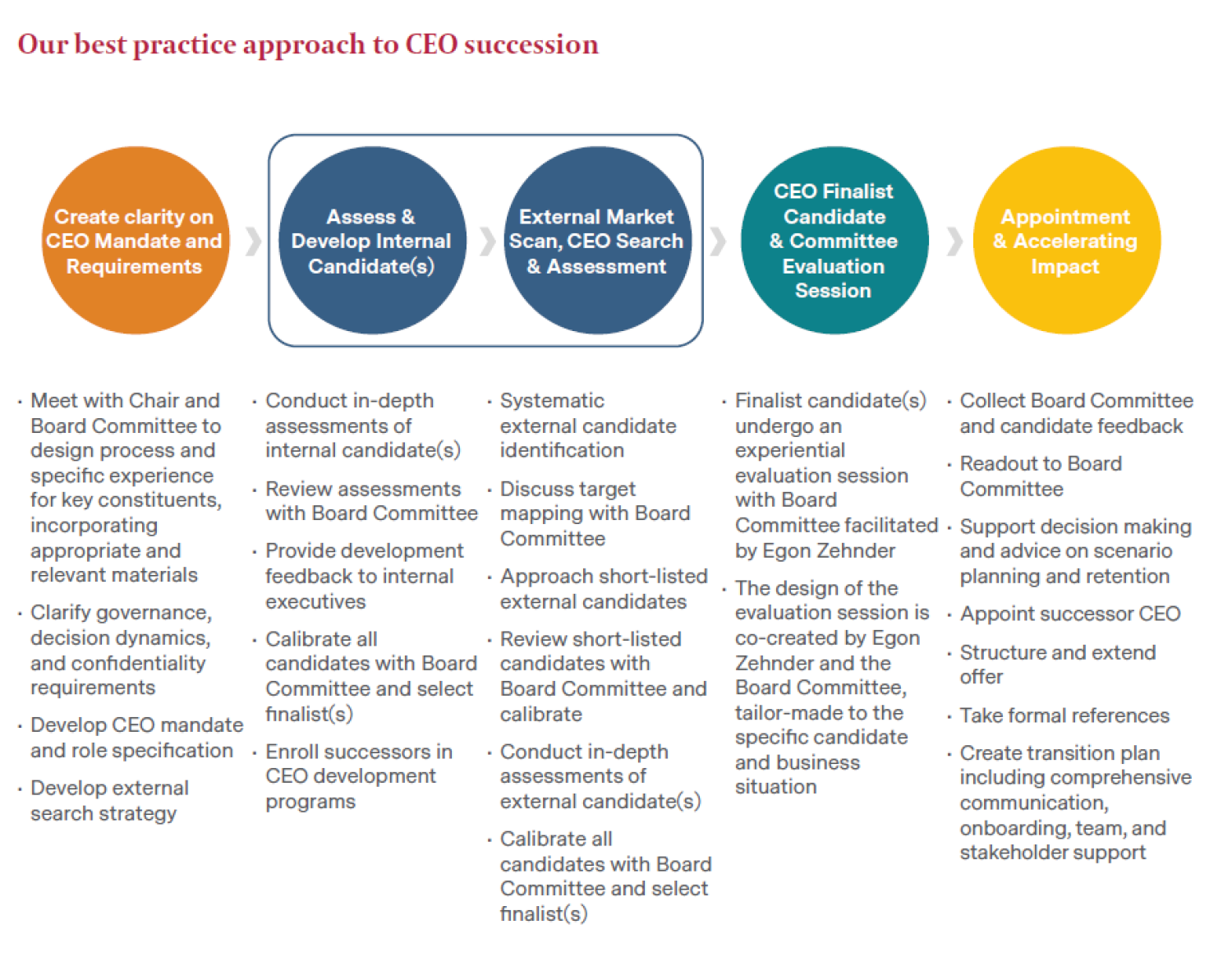Across various industries, CEO tenures have become shorter, and departures have become more frequent—and sometimes more sudden. This trend is also prominent in Academic Medical Centers (AMCs), where the challenge can be exacerbated by varying levels of maturity when it comes to CEO succession planning. As a result, many AMC systems are compelled to seek external candidates, even for interim leadership, during CEO transitions, suggesting that the internal talent pool is not being developed sufficiently for effective succession planning.
Given the unprecedented pressure on boards to deliver quality patient care and ensure financial health, developing a robust internal pipeline for CEO succession has become an essential component of their mandate. To understand how health systems in academic medicine are faring on CEO succession, we analyzed CEO successions in 103 AMC health systems across the United States over the course of a decade (from 2013 to 2022) including 105 CEOs (two systems had co-CEOs).
Our analysis highlights a significant opportunity for AMCs to enhance their long-term CEO succession planning and talent development efforts. Adopting a multi-path approach that emphasizes long-term growth will help ensure leadership stability and continuity, which is essential for maintaining high standards of care and operational efficiency.
Key findings:
- CEO turnover is a real challenge for AMCs. Over the past decade, more than 80% of the AMC health systems we analyzed experienced CEO turnover. One-third of the outgoing CEOs served in the role for less than five years.
-
Internal promotions are not keeping up with best practices. Only 60% of CEO transitions were internal promotions, demonstrating a significant gap when compared to large global corporations, where typically more than 80% of CEO transitions are internal promotions. -
Over half of AMC health system CEO transitions required an interim CEO, and nearly half of those systems ultimately hired a permanent CEO from outside the organization. This further implies that AMC systems are not sufficiently prepared for CEO transitions ahead of time. -
The profile of AMC health system CEOs is shifting, if only slightly. 20% of AMC health system CEOs are female, which is notably higher than in other industries. This representation continues to increase, albeit slowly. The proportion of CEOs who are MDs has remained relatively stable around 50%.
The Imperative for Cultivating Internal Talent in Health Systems
Our study, as well as our client work over the years, reveals a widespread trend: AMC health systems – and in fact, all health systems – generally lag in developing their internal talent pool over time, creating significant challenges for effective CEO succession planning.
What sets AMC health systems apart from other industries is the broader community implications they have. AMCs serve as essential pillars of their communities, with an impact extending well beyond their walls. Leading effectively in this environment takes specific leadership traits and established trust with community stakeholders, including state and local governments, academic leaders, and local organizations. These connections are crucial for navigating regulatory and regional nuances, as well as ultimately delivering the best possible healthcare outcomes for the community served.
We found that most externally appointed CEOs come from other health systems. However, leaders who have grown from within the system tend to be better positioned to leverage these relationships and understand the unique challenges and opportunities of their specific environment. By underinvesting in their leadership development for a potential CEO opportunity or other C-suite role, AMC health systems lose out on the unique viewpoint their internal talent may already possess.

Another finding sheds light on the reality of several AMC health systems resorting to an interim CEO—most ultimately conducting an external search instead of promoting from within. As an industry, there is a massive opportunity for bridging this gap through a more refined approach to CEO succession planning.

For these reasons, boards of AMC health systems must change this pattern and embed long-term, strategic CEO succession planning within their systems. Moreover, including executive development initiatives as part of CEO succession planning sends a strong signal that internal talent is valued and worthy of significant investment. It also sets the health system up for success and creates opportunities that wouldn’t otherwise exist when it comes to talent and leadership succession for other C-suite positions.
These developmental pathways involve multiple approaches. For the current CEO, understanding the organization’s present state and future direction helps identify individuals who can thrive amid future challenges and grow with the role. Leadership must then provide individual development opportunities and facilitate vertical growth.
Given that nearly half of AMC CEOs are medical doctors, bringing invaluable clinical expertise, transitioning to the CEO role requires a different skill set focused on strategic leadership. Investing in leadership development tailored to medical professionals can bridge this gap, ensuring that physician-leaders are well-prepared for executive roles.
Guiding the CEO Succession Planning Process
Best practice CEO succession is a comprehensive, long-term, multi-path approach. First and foremost, it involves a strong partnership between the board and the current CEO. An example of a fruitful partnership is in the case study of Mastercard, where succession discussions between the incoming CEO and the board chair began five years in advance, and over 40 potential successors were identified and went through a personalized leadership development journey, ultimately leading to a seamless internal promotion for the next CEO (read the full case study on Harvard Business Review). Though the business dynamics and context in a large global business are very different from those of an AMC, the core principles still apply.
Additionally, understanding what success looks like in the future for the health system and how that differs from today is crucial. When navigating this process, some key questions for the board to ask include:
- Person: How would you describe the leadership that the company needs in the next phase? What are the key essentials for the CEO and their leadership and personality traits?
-
Position: What is the mandate for the future CEO? What type of team will they inherit, and how might they need to shape the broader culture? -
Process: What is the timing and what are the critical dependencies, roles, and responsibilities? How will internal candidates be identified?

A best practice approach to CEO succession includes not only the development of the CEO mandate based on the questions above. The approach must be long-term and multi-level, identifying top talent within the organization and guiding them through assessment and subsequent development paths to prepare them for future roles. Often this is done in parallel with an external market scan to understand all options and potential profiles for the future CEO.
Potential successors often go through a long-term journey that does not only include leadership development support (e.g., coaching and mentoring, targeted training for skill development, etc.) but also includes the creation of new roles and responsibilities over time to round out the entirety of experiences needed for the future leader. For example, health system leaders could make functional moves over time (e.g. moving from Strategy to HR leadership roles). Non-clinical leaders could gain more direct exposure to clinical operations, and physician leaders could take on targeted responsibilities to gain experience in business development or other financial activities to round out their skill sets within the system. And, importantly, hospital site leaders in one part of a system could gain experience by working in different facilities or regions of the system over time.

Embedding CEO Succession Best Practices Within Health Systems
CEOs and boards in health systems have a major opportunity to rethink CEO succession planning processes. These organizations require leaders with deep internal experience who can effectively address market challenges, contain costs, and foster growth—all while delivering healthcare to patients and saving lives every day. Empirical evidence suggests that leaders embedded within the system understand its unique dynamics and are better positioned to thrive when development opportunities are available to them.
Importantly, the benefits of robust long-term succession planning are many. Not only is there a massive benefit to leaders at all levels within the institution, as they upskill and broaden their experiences and exposure over time, but there is also a significant reduction in instability (both within the institution and for the broader community) that occurs during an external search and transition period (as noted by the many interim CEOs that this industry has seen recently). All of these benefits put together result in a better journey for the entire organization.
With a high level of complexity, the succession process in AMCs should ensure a smooth transition in any scenario—whether it's an emergency, a planned CEO departure, or a longer-term succession plan. As systems make important progress toward improving healthcare outcomes and operational efficiencies, prioritizing CEO succession planning can lead to even better results – for the board and leadership teams, for the workforce overall, and most importantly, for the patients and communities served.
Acknowledgements
Egon Zehnder thanks Vizient, Inc. for its collaboration on this publication.





